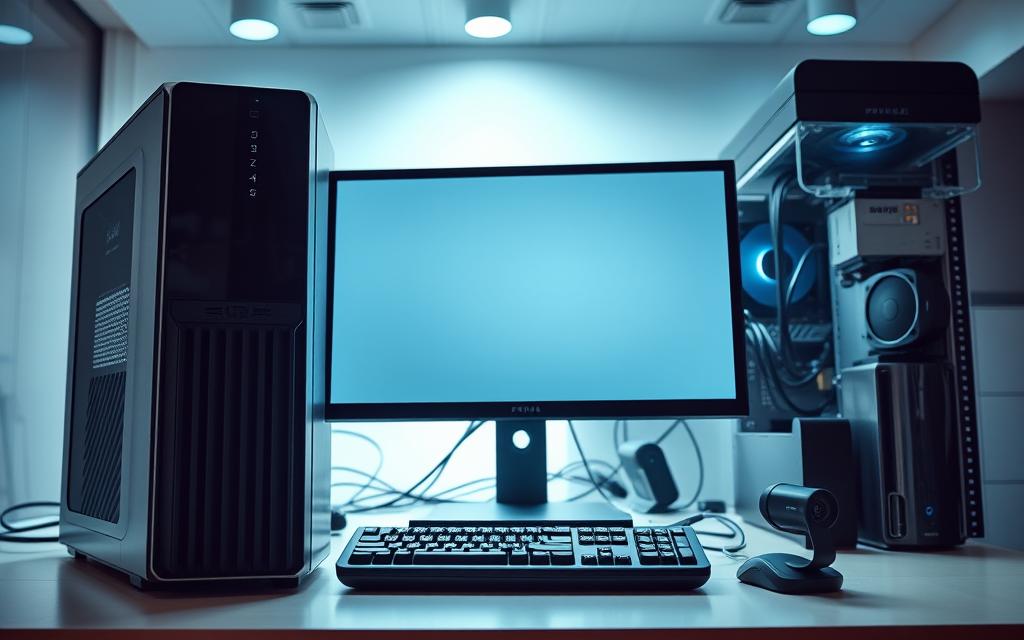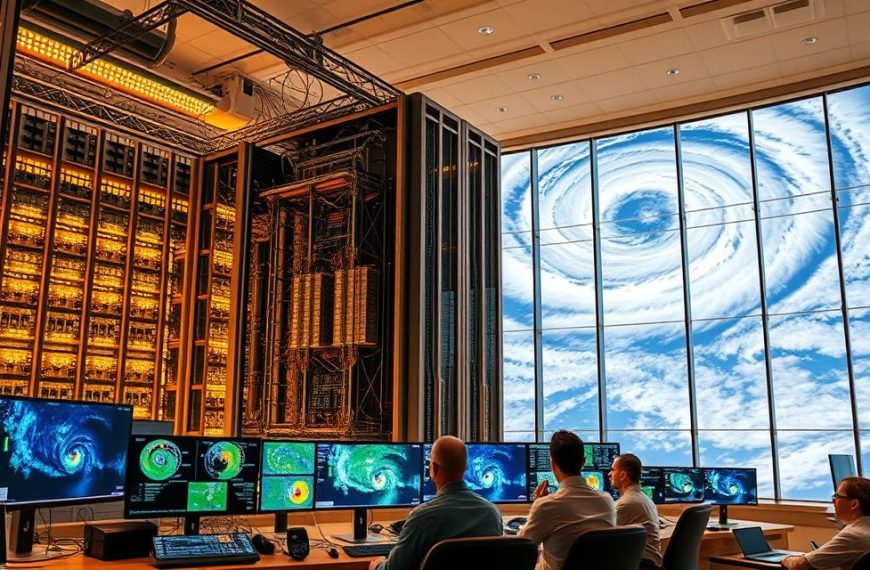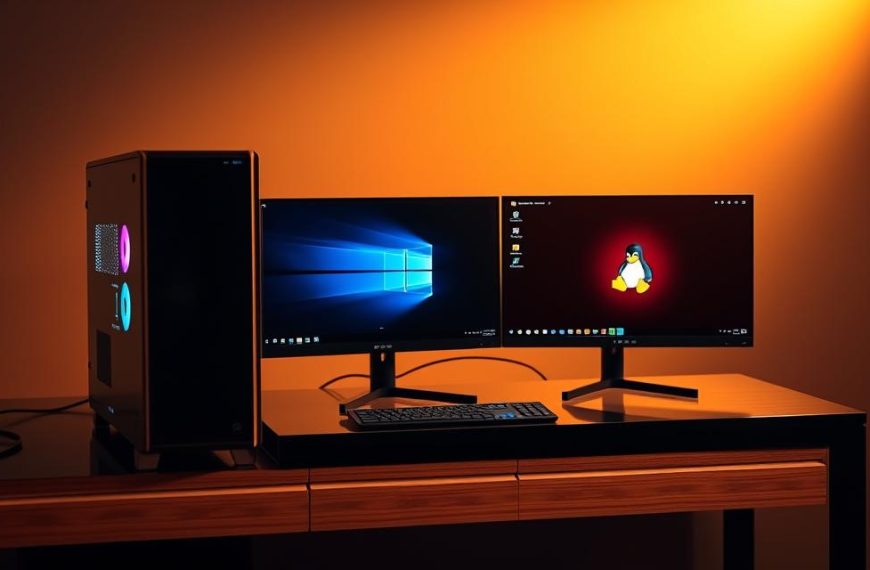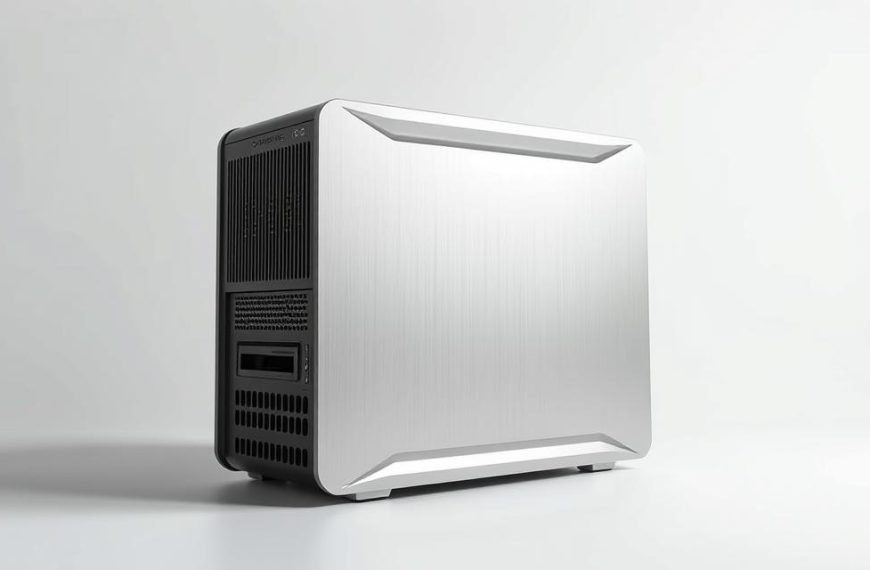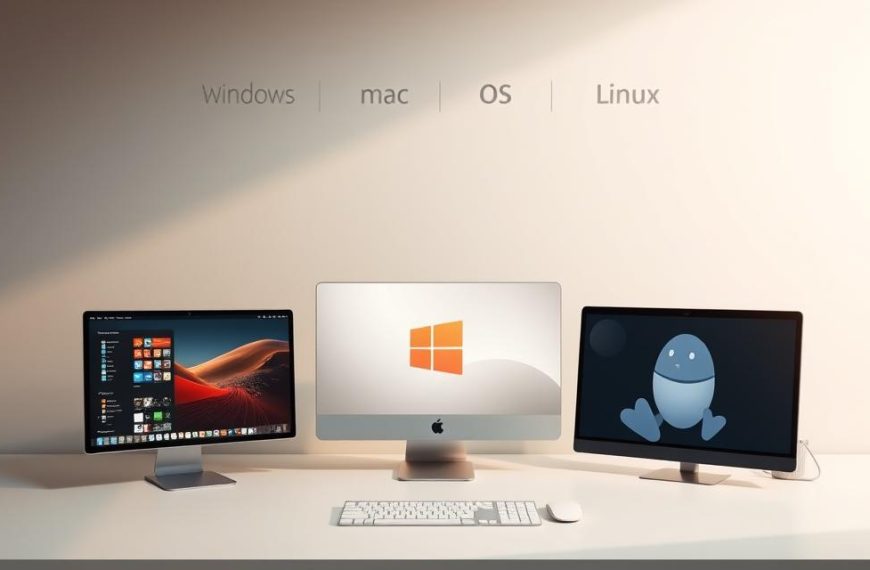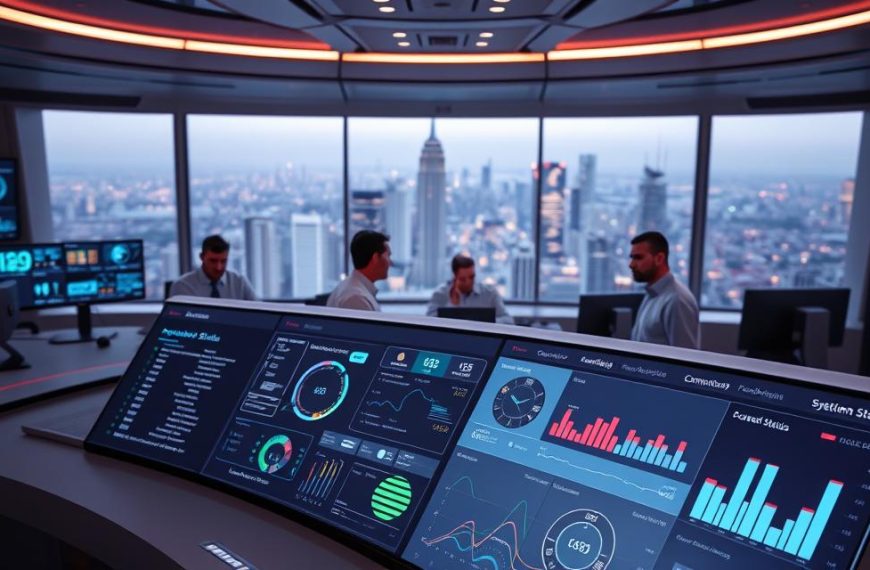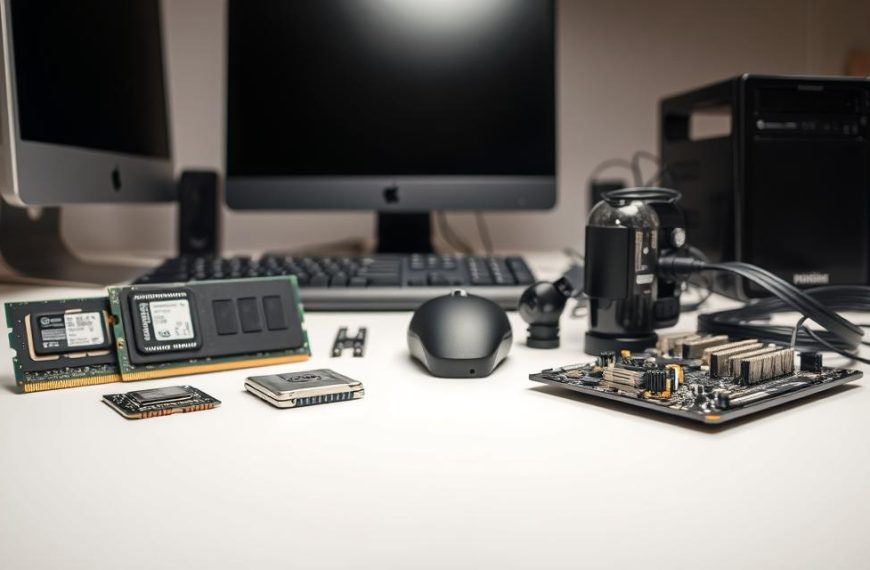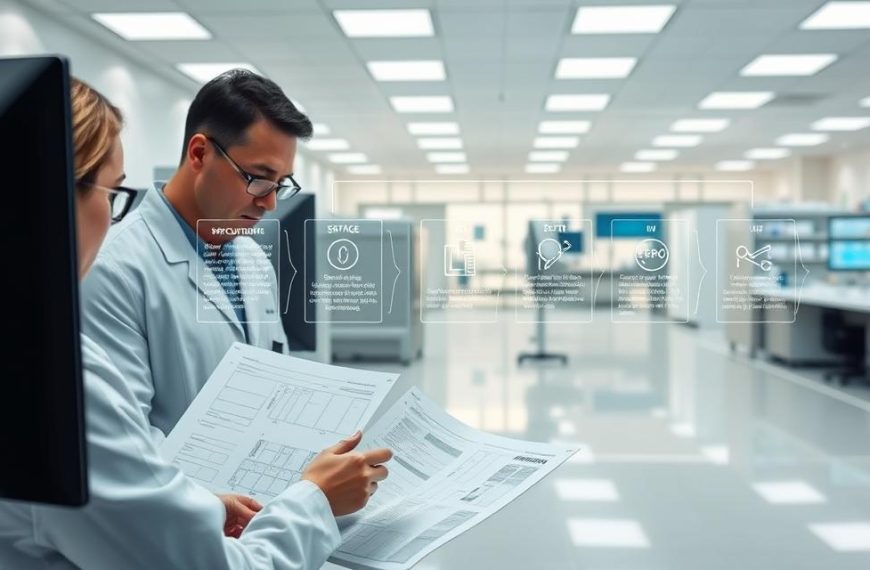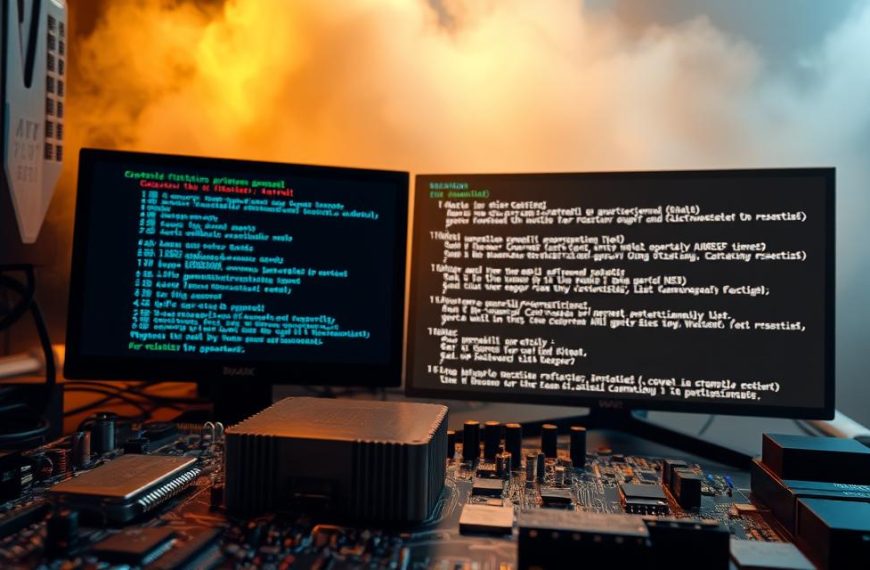A computer system is an electronic device that processes information with great accuracy. It takes in raw data, does complex tasks, shows results, and stores them as needed.
Every modern computer uses both hardware and software to work well. These parts together offer many functions that shape our digital lives.
The way these parts work together is called computer architecture. It’s a set of rules that helps hardware and software talk and work together smoothly.
All computers, no matter their type or use, have basic components. Knowing these parts helps us understand how technology affects our daily lives.
Defining a Computer System and Its Purpose
A computer system is a electronic device that processes information very efficiently. It works by taking in data, doing operations, showing results, and storing info as needed.
Today’s computers are incredibly useful. They can do millions of calculations every second. Unlike us, they work perfectly without getting tired or making mistakes if they’re programmed right.
- Speed: Processes data at incredible rates measured in calculations per second
- Accuracy: Follows programmed instructions without deviation
- Diligence: Operates continuously without performance degradation
- Versatility: Handles multiple tasks and operations simultaneously
- Storage capacity: Retains massive amounts of data for immediate retrieval
These traits make computers useful in many areas. They help with personal tasks and big industrial jobs. Computers improve how we work and what we can do.
Computers have changed how we solve problems and handle information. This electronic device is key to our modern world. It helps with simple tasks and complex science projects.
| Computer Characteristic | Practical Application | Benefit to Users |
|---|---|---|
| Processing Speed | Real-time data analysis | Instant results and decisions |
| Storage Capacity | Large database management | Access to historical information |
| Operation Accuracy | Financial calculations | Error-free transactions |
| Multitasking Ability | Running multiple applications | Increased productivity |
| Data Retrieval | Information searching | Quick access to needed data |
Knowing how computers work helps us use them better every day. This knowledge is key for using computers at home and at work.
The wide range of computer functionality makes them very important. They help with research, business, creativity, and more. They drive progress and new ideas.
Hardware: The Physical Components of a Computer System
Every computing experience starts with the physical parts we touch every day. These physical computer parts make up what we call computer hardware. They are the foundation for all digital work. Unlike software, these parts are tangible and essential for processing, storing, and sharing information.
Internal Hardware: The Core Internals
The inner workings of a computer are complex. They rely on internal components that handle critical tasks. These parts work together inside the computer case, from simple calculations to complex graphics.
The Central Processing Unit (CPU): The Brain
The CPU is like the computer’s brain. It carries out instructions from programmes and apps. Modern CPUs work at speeds in gigahertz, handling billions of calculations per second. The CPU’s speed affects how fast your system responds.
Random Access Memory (RAM): Short-Term Memory
RAM is the computer’s temporary memory. It stores data for programmes that are currently running. This memory is lost when power is turned off. But it offers fast access for running apps. More RAM means better multitasking.
Motherboard: The Central Nervous System
The motherboard is the main circuit board. It connects all internal parts. It’s like the central nervous system, coordinating all hardware operations.
Storage Devices: Hard Disk Drives (HDD) and Solid State Drives (SSD)
Storage devices keep your data safe when the computer is off. HDDs use magnetic disks, while SSDs use flash memory for faster access. SSDs are popular for their speed, but HDDs offer more storage at a lower cost.
Graphics Processing Unit (GPU): Handling Visuals
GPUs handle images, videos, and animations. Integrated graphics are enough for basic needs, but dedicated graphics cards offer better performance for gaming and video editing.
Power Supply Unit (PSU): Delivering Energy
The PSU turns wall outlet electricity into stable voltages for computer components. It powers the motherboard, storage drives, and other parts. A reliable PSU is key for system stability and part longevity.
External Hardware: Peripherals and Interfaces
External peripherals let us interact with the system. They connect through ports and interfaces, adding functionality for specific tasks and user preferences.
Input Devices: Keyboards, Mice, and Scanners
Input devices turn human actions into digital signals. Keyboards and mice offer different ways to interact. Scanners convert documents into digital formats.
Output Devices: Monitors, Printers, and Speakers
Output devices show information in ways we can understand. Monitors use LCD, LED, or OLED for visuals. Printers make physical copies, and speakers turn signals into sound.
Storage and Connectivity: External Drives and Ports
External drives like USB flash drives and hard drives offer portable storage. Ports like USB-C, Thunderbolt, and HDMI enable connections. These interfaces are getting faster and more compatible.
Software: The Programmes and Data
Hardware is the physical base of any computer. But it’s the software that makes it work. Software gives computers instructions and data, turning them into tools for work, creativity, and talking to others.
System Software: Operating Systems Like Windows and macOS
The heart of any computer is its operating system. It connects hardware and user apps. Systems like Microsoft Windows and macOS manage things like memory and device communication.
These systems let users interact with their computers. They handle important tasks like memory management and device control.
- Memory management and allocation
- Process scheduling and multitasking
- Device driver management
- File system organisation
- User authentication and security
Without an operating system, even the most advanced hardware is useless. Today’s operating systems have features like virtual memory and advanced security.
Application Software: Programmes for Specific Tasks
Application software is for specific tasks. It’s different from system software, which manages the computer. These programmes meet user needs in many areas.
The computer software types include:
- Productivity suites like Microsoft Office for documents
- Creative tools like Adobe Creative Cloud for editing
- Communication tools like email and video calls
- Business apps for accounting and project management
- Educational software for learning
Each type of application programme uses the operating system to work. They turn computing power into useful tools for work and fun.
Security software is also important. It keeps systems safe from threats. This includes antivirus, firewalls, and encryption tools that work with operating systems.
How All Components Work Together Seamlessly
Modern computing is amazing because all parts work together perfectly. This makes each part work as one, responding quickly to what you do.
At the core is how data moves in computers. It goes from input to processing to output. When you type, signals go from the keyboard to the CPU, starting a series of actions.
The CPU uses a cycle to handle instructions. It gets commands, figures out what to do, and does the math. This happens a lot, really fast.
Let’s say you’re making a document:
- The keyboard captures your keystrokes as input data
- This information travels via the motherboard to the CPU
- The processor works with RAM to temporarily store active data
- Your operating system manages the application software
- Final results appear on the monitor through graphics processing
- The storage drive saves your work for future access
This shows how hardware and software work together. The operating system is the boss, sorting out tasks and resources.
For tasks like video editing or gaming, things get more complex. The GPU is key for graphics, working with the CPU for smooth visuals.
The motherboard is like the brain, connecting everything. It makes sure data moves well between parts.
This complex system is what makes computers work well. Each part does its job, making everything run smoothly.
Knowing how data flows helps us see the genius behind computers. From simple tasks to complex simulations, it all works thanks to these parts.
Conclusion
A computer system is a mix of hardware and software working together. Each part, like the CPU and operating system, is vital. Knowing this helps users keep their systems in top shape.
Understanding technology basics helps make smart choices, like upgrading to an SSD or adding RAM. It also helps fix common problems, keeping your device running well. Regular updates and careful use can make your computer last longer.
This summary shows how important it is to know about both the physical and programmatic sides of computers. Whether you use Windows, macOS, or other software, this knowledge improves performance and lifespan. Keep learning and applying these principles for the best computing experience.

